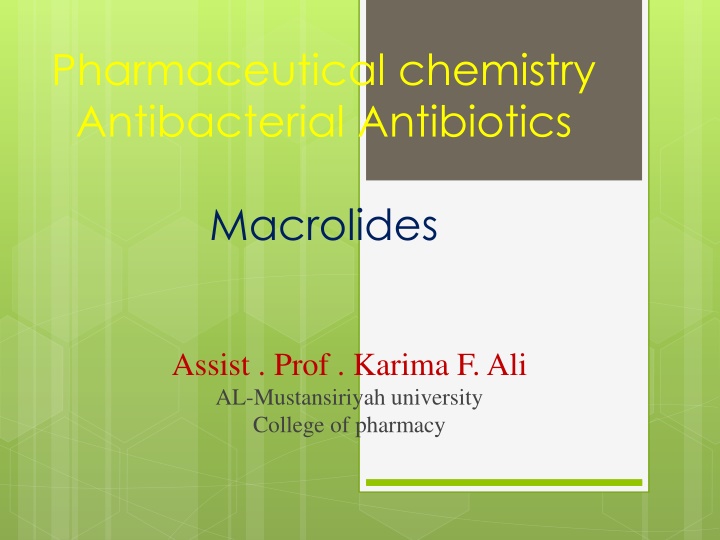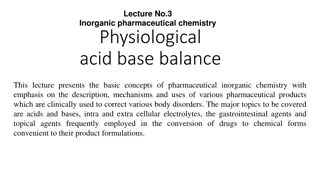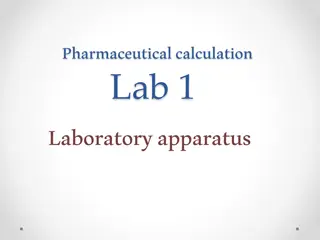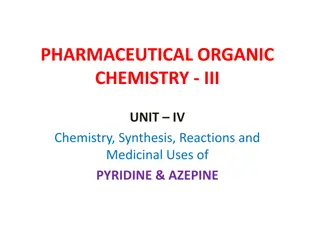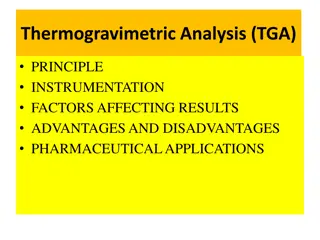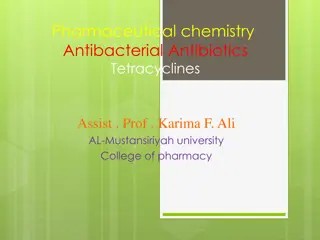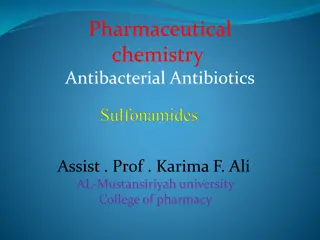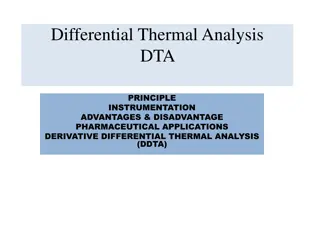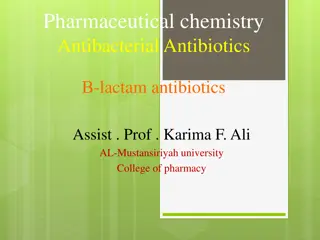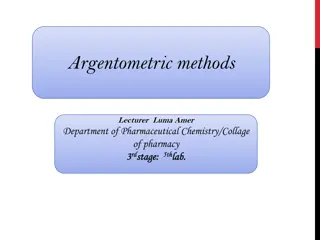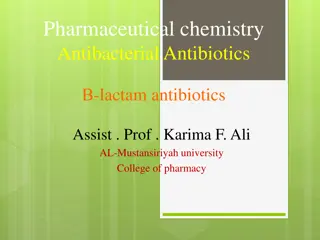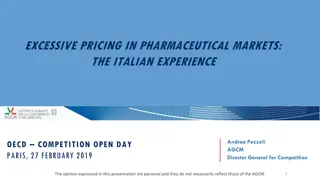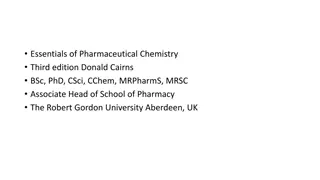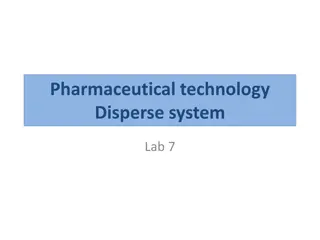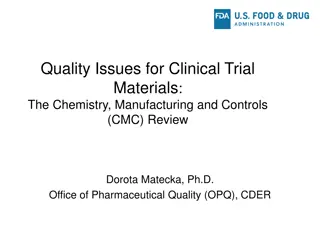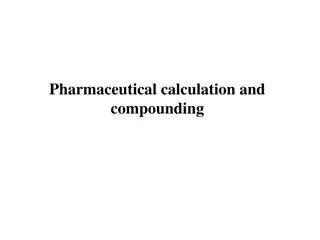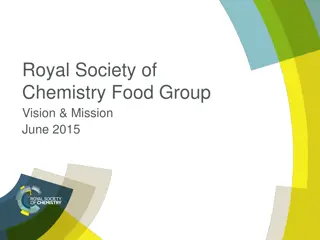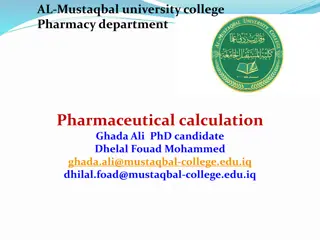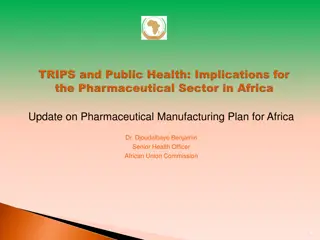Antibacterial Macrolides in Pharmaceutical Chemistry
Macrolide antibiotics like erythromycin play a crucial role in combating bacterial infections due to their unique chemical characteristics and mechanisms of action. These antibiotics are effective against a wide spectrum of bacteria, making them essential tools in the field of pharmaceutical chemistry. Explore the details of macrolides, their mechanisms of action, spectrum of activity, and commercial products like erythromycin A and B.
Download Presentation

Please find below an Image/Link to download the presentation.
The content on the website is provided AS IS for your information and personal use only. It may not be sold, licensed, or shared on other websites without obtaining consent from the author.If you encounter any issues during the download, it is possible that the publisher has removed the file from their server.
You are allowed to download the files provided on this website for personal or commercial use, subject to the condition that they are used lawfully. All files are the property of their respective owners.
The content on the website is provided AS IS for your information and personal use only. It may not be sold, licensed, or shared on other websites without obtaining consent from the author.
E N D
Presentation Transcript
Pharmaceutical chemistry Antibacterial Antibiotics Macrolides Assist . Prof . Karima F. Ali AL-Mustansiriyah university College of pharmacy
4. Macrolides The macrolide antibiotics have three common chemical characteristics: (a) a large lactone ring (which prompted the name macrolide), (b) a ketone group (c) a glycosidically linked amino sugar. Usually, the lactone ring has 12, 14, or 16 atoms in it, and it is often unsaturated, with an olefinic group conjugated with the ketone function.
Mechanism of Action and Resistance Some details of the mechanism of antibacterial action of erythromycin are known. It binds selectively to a specific site on the 50S ribosomal subunit to prevent the translocation step of bacterial protein synthesis. It does not bind to mammalian ribosomes. Broadly based, nonspecific resistance to the antibacterial action of erythromycin among many species of Gram- negative bacilli appears to be largely related to the inability of the antibiotic to penetrate the cell walls of these organisms
Spectrum of Activity The spectrum of antibacterial activity of the more potent macrolides, such as erythromycin, resembles that of penicillin. The macrolides are generally effective against most species of Gram-positive bacteria, both cocci and bacilli, and exhibit useful effectiveness against Gram- negative cocci, especially Neisseria spp. Many of the macrolides are also effective against Treponema pallidum.
Products Erythromycin The commercial product is erythromycin A, which differs from its biosynthetic precursor, erythromycin B, in having a hydroxyl group at the 12-position of the aglycone. The B analog is more acid stable but has only about 80% of the activity of erythromycin. The C analog differs from erythromycin by the replacement of the methoxyl group on the cladinose moiety with a hydrogen atom. It appears to be as active as erythromycin but is present in very small amounts in fermentation liquors..
Erythromycin A Erythromycin B The amino sugar attached through a glycosidic link to C-5 is desosamine, a structure found in several other macrolide antibiotics. The tertiary amine of desosamine (3,4,6- trideoxy-3 dimethyl amino-D-xylo-hexose) confers a basic character to erythromycin and provides the means by which acid salts may be prepared.
The other carbohydrate structure linked as a glycoside to C-3 is called cladinose (2,3,6- trideoxy-3-methoxy -3-C-methyl-L-ribo-hexose) and is unique to the erythromycin molecule. Erythromycin is unstable in acid media. The hydroxyl group reversibly attack the C-9 ketone giving rise to a hemiketal intermediate. Dehydration prevents regeneration of parent erythromycin and the C-12 hydroxyl group can subsequently add to produce a spiro-ketal species. C6
Erythromycin has been chemically modified with primarily two different goals in mind: (a) Increase either its water or its lipid solubility for parenteral dosage forms and (b) Increase its acid stability (and possibly its lipid solubility) for improved oral absorption. The nucleophilic functionality of 6-hydroxyl group Initiate Erythromycin degradation. If the size of the group kept small so as not to affect the ribosomal binding.
Modified derivatives of the antibiotic are of two types: 1. acid salts of the dimethyl amino group of the desosamine moiety (e.g., the glucoheptonate, the lactobionate, and the stearate) 2. esters of the 2 -hydroxyl group of the desosamine (e.g., the ethylsuccinate and the propionate, available as the lauryl sulfate salt and known as the estolate). The stearate salt and the ethylsuccinate and propionate esters are used in oral dose forms intended to improve absorption of the antibiotic. The stearate releases erythromycin base in the intestinal tract, which is then absorbed.
1. Acid salts of the dimethyl amino group: Erythromycin Lactobionate Erythromycin lactobionate is a water-soluble salt prepared by reacting erythromycin base with lactobiono- -lactone.
2. Esters of the 2-hydroxyl group Erythromycin stearate (Ethril, Wyamycin S, Erypar) is the stearic acid salt of erythromycin. It is film coated to protect it from acid degradation in the stomach. In the alkaline pH of the duodenum, the free base is liberated from the stearate and absorbed. Erythromycin Stearate
Erythromycin EryPed) erythromycin in which the 2 -hydroxyl group of the desosamine is esterified. It is absorbed as the ester and hydrolyzed slowly in the body to form erythromycin. Ethylsuccinate the Ethylsuccinate (EES, Pediamycin, mixed ester is of Erythromycin Ethylsuccinate
3. Methylation of the 6-hydroxyl group: Clarithromycin The simple methylation of the 6-hydroxyl group of erythromycin creates a semisynthetic derivative that fully retains the antibacterial properties of the parent antibiotic, with markedly increased bioavailability and reduced GI side effects associated with erythromycin. acid stability and oral Clarithromycin
Azithromycin Azithromycin derivative of erythromycin, prepared by Beckman rearrangement of the corresponding oxime, followed by N methylation and reduction of the resulting ring- expanded lactam. It is a prototype of a series of nitrogen-containing, 15-membered ring macrolides known as azalides. Removal of the 9-keto group coupled with incorporation of a weakly basic tertiary amine nitrogen function into the macrolide ring increases the stability of azithromycin to acid- catalyzed degradation (Zithromax) is a semisynthetic
These changes also increase the lipid solubility of the molecule, thereby conferring unique pharmacokinetic and microbiological properties
Oleandomycin, as its triacetyl derivative. Its structure consists of two sugars and a 14-member lactone ring designated an oleandolide.. The sugars are linked glycosidically to the positions 3 and 5, respectively, of oleandolide. Oleandomycin contains three hydroxyl groups that are subject to acylation, one in each of the sugars and one in the oleandolide.
5. Lincomycins The lincomycins are sulfur-containing antibiotics isolated from Streptomyces lincolnensis. Extensive efforts to modify the lincomycin structure to improve its antibacterial properties resulted in the preparation of the 7-chloro- 7-deoxy derivative Clindamycin. Clindamycin appears to have the greater antibacterial potency and better pharmacokinetic properties. and pharmacological
Lincomycin-related antibiotics differ in structure at one or more of three positions of the lincomycin structure: (a) The N-methyl of the hygric acid moiety is substituted by a hydrogen (b) The n-propyl group of the hygric acid moiety is substituted by an ethyl group (c) The thiomethyl ether of the -thiolincosamide moiety is substituted by a thioethyl ether.
Lincomycin Hydrochloride The structure contains a basic function, the pyrrolidine nitrogen, by which water-soluble salts with an apparent pKa of 7.6 may be formed.
Lincomycin binds to the 50S ribosomal subunit to inhibit protein synthesis. bacteriostatic or bactericidal depending on various factors, including the concentration of the antibiotic. When subjected to hydrazinolysis, lincomycin is cleaved at its amide propylhygric acid (the pyrrolidine moiety) and methyl -thiolincosamide (the sugar moiety). Its action may be bond into trans-L-4-n- .
Clindamycin Hydrochloride Replacement of the 7(R)-hydroxy group of lincomycin by chlorine with inversion of configuration resulted in a compound with enhanced antibacterial activity in vitro. Clinical experience with this clindamycin, 7(S)-chloro-7- released in 1970, has established that its superiority over lincomycin is even greater in vivo. Changes in the - thiolincosamide portion of the molecule seem to decrease activity markedly. semisynthetic deoxylincomycin derivative, (Cleocin),
6. Polypeptides Antibiotics Among the most powerful bactericidal antibiotics are those that possess a polypeptide structure. Antibiotics of the polypeptide class differ widely in their mechanisms of action and antimicrobial properties. Bacitracin and vancomycin interfere with bacterial cell wall synthesis and are effective only against Gram-positive bacteria. Neither antibiotic apparently can penetrate the outer envelope of Gram-negative bacteria. Both the gramicidins and the polymyxins interfere with cell membrane functions in bacteria. However, the gramicidins are effective primarily against Gram-positive bacteria, whereas the polymyxins are effective only against Gram-negative species.
7. Unclassified antibiotics Chloramphenicol The antibiotics. It possesses two chiral carbon atoms in the acylamidopropanediol chain. resides almost exclusively in the D-threo isomer; the L-threo and the D- and L-erythro isomers are virtually inactive. Numerous structural chloramphenicol have been synthesized to provide a basis for correlation of structure to antibiotic action. first of the widely used broad-spectrum Biological activity analogs of
It appears that the p-nitrophenyl group may be replaced by other aryl structures without appreciable loss in activity. Substitution on the phenyl ring with several different types of groups for the nitro group, a very unusual structure in biological products, does not greatly decrease activity. All such compounds yet tested are less active Modification of the side chain shows that it possesses high specificity in structure for antibiotic action. Conversion of the alcohol group on C-1 of the side chain to a keto group causes appreciable loss in activity. than chloramphenicol.
The investigated thoroughly. The main path involves formation of the 3-O- glucuronide. Minor reactions include reduction of the p-nitro group to the aromatic amine, hydrolysis of the amide, and hydrolysis of the -chloracetamido group, followed by reduction to give the corresponding hydroxyacetyl derivative. metabolism of chloramphenicol has been
